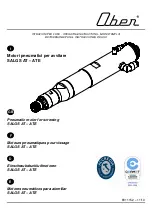
be drawn into the turning prop causing injury or damage.
Engine installation
1. Make sure each engine comes with a firewall mounting plate
drilled with four holes for #10 size screws.
2. A spacer is needed to keep the cooling fins away from the
firewall where the firewall is larger than the engine plate.
3. In order to make sure the engine does not speed excessively
without a positive control installed, throttle return springs
must be left in place.
4. After you have connected the return spring to the throttle
servo you may unhook it
(
do not remove it
)
, since it acts as
a spacer for the butterfly. The butterfly will work loose by
removing the return spring.
5. The ignition battery should be mounted externally, near the
cowl, at least twelve inches from the receiver or throttle servo
that connects to the receiver.
6. The carburetor needs at least 1 1/2" (38mm) of clearance
between the intake and the bottom of the cowl. If there is less
than 1 1/2", make an opening in the cowl below the
carburetor at least as large as the carburetor intake diameter.
7. A long, narrow, screw driver is recommended to drill small
holes in the cowl for adjusting the needle valves, since the
carburetor must often be adjusted differently with the cowl on
as compared to off.
8. The engines are equipped with a diaphragm pump carburetor
making tank location not critical relative to the carburetors
fuel entry position. Place the tank on the aircraft’s center of
gravity (CG).
Then aircraft trim changes during flight will not
be necessary from a full to an empty tank
FUEL:
Clean petrol 93# is strongly recommended for your DLA
engines. Lubrication Ratio of trial Run is 25:1~30:1, while
normal flying is 40:1~50:1, Higher-octane fuel will not generate
more power and may cause the engine to run slower and
overheat.
Note:
Damage caused by fuel additives, such as nitro,




























